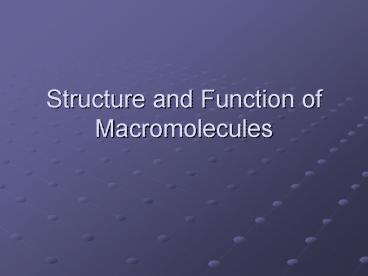Structure and Function of Macromolecules - PowerPoint PPT Presentation
1 / 30
Title:
Structure and Function of Macromolecules
Description:
Monomers: repeating units that serve as building blocks for polymers ... BUT, the fibrils of cellulose abrade the wall of the digestive tract and ... – PowerPoint PPT presentation
Number of Views:37
Avg rating:3.0/5.0
Title: Structure and Function of Macromolecules
1
Structure and Function of Macromolecules
2
Monomers, Polymers, and Macromolecules
- Monomers repeating units that serve as
building blocks for polymers - Polymers long molecule consisting of many
similar or identical building blocks linked by
covalent bonds - Macromolecules groups of polymers covalently
bonded 4 classes of organic macromolecules to
be studied - 1. Carbohydrates 3. Proteins
- 2. LiPIDs 4. Nucleic Acids
3
How to the monomers link up/break back into
monomers?
- Condensation reaction (specifically, dehydration
synthesis) - two molecules covalently bond and lose a water
molecule in the process - (THIS TAKES ENERGY TO DO!!!)
- Hydrolysis
- polymers are disassembled to monomers by
adding a water molecule back - (ex. Digestion of food)
4
Figure 5.2 The synthesis and breakdown of
polymers
5
Key to diversity of polymers from limited
monomers available
- ARRANGEMENT variation in the linear sequence
the units follow - (think of the number of words possible from
our 26 letter alphabet) - Molecular logic of life is simple but elegant
and ORDERLY!!!
6
Organic Compounds and Building Blocks
- Carbohydrates made up of linked
monosaccharides - Lipids -- CATEGORY DOES NOT INCLUDE POLYMERS
(grouping based on insolubility) - Triglycerides (glycerol and 3 fatty
acids) - Phospholipids
- Steroids
7
- Proteins made up of amino acids
- Nucleic Acids made up nucleotides
8
Carbohydrates fuel and building material
- Exist as three types
- 1. monosaccharides
- 2. disaccharides
- 3. polysaccharides (macromolecule stage)
- Made up of C, H, and O
- Has carbonyl group and multiple hydroxyl groups
(location of carbonyl determines if is an aldose
or a ketose - Names end in ose
- Size of carbon skeleton determines category
9
Figure 5.3 The structure and classification of
some monosaccharides
10
In aqueous solns, most sugars form rings
11
Monosaccharides
- Are major sources of energy for cells
- Ex. Glucose cellular respiration
- Are simple enough to serve as raw materials for
synthesis of other small organic molecules such
as amino and fatty acids - Most common glucose, fructose, galactose
12
Glucose, Fructose, Galactose
- Glucose made during photosynthesis
- main source of energy for plants and
animals - Fructose found naturally in fruits
- is the sweetest of monosacc
- Galactose found in milk
- is usually in association with glucose
or fructose - All three have same molecular formula but
differstructurally so are ISOMERS
13
Disaccharides
- Consists of two monosaccharides joined by a
GLYCOSIDIC LINKAGE a covalent bond resulting
from dehydration synthesis - Ex. Maltose 2 glucoses joined
- Sucrose glucose and fructose
- Lactose glucose and galactose
14
Figure 5.5 Examples of disaccharide synthesis
15
Figure 5.5x Glucose monomer and disaccharides
Glucose monomer
Sucrose
Maltose
16
Polysaccharides
- These are the polymers of sugars the true
macromolecules of the carbs - Serve as storage material that is hydrolyzed as
needed in body or as structural units that
support bodies of orgs
17
Storage Polysaccharides Starch and Glycogen
- Starch found in plants
- made up of glucose monomers in alpha
configuration - has a helical shape
- can be unbranched (amylose) or branched
(amylopectin) - stored as granules in plants in the
PLASTIDS - (these granules are stockpiles of glucose for
later use carb BANK) - You can find starch in potatoes and grains
18
- Glycogen found in animals
- extensively branched group of glucose
units - stored in liver and muscle cells
- glycogen bank is depleted within 24
hours needs replentishing
19
Figure 5.6 Storage polysaccharides
20
Structural Polysaccharides
- Cellulose major component of plant cell
walls - most abundant organic compound on Earth
- polymer of glucose, but all glucose
molecules are in the beta configuration - thus, cellulose is always straight, and
this provides for strength (Ex. Lumber)
21
Figure 5.7a Starch and cellulose structures
22
Figure 5.7b,c Starch and cellulose structures
23
Figure 5.7x Starch and cellulose molecular
models
? Glucose
? Glucose
Cellulose
Starch
24
Figure 5.8 The arrangement of cellulose in plant
cell walls
25
Cellulose and the diet
- Few orgs possess the enzymes to digest cellulose
- Cellulose passes through the digestive tract and
is eliminated in feces - BUT, the fibrils of cellulose abrade the wall of
the digestive tract and stimulate secretion of
mucus which is necessary for smooth food passage
so though cellulose is not nutritious, it is
necessary - Orgs that can digest cows (with help of
bacteria), termites (with help of microbes), some
fungi
26
Figure 5.x2 Cellulose digestion cow
27
Figure 5.x1 Cellulose digestion termite and
Trichonympha
28
Chitin
- Another structural polysaccharide
- Used by arthropods to build their exoskeletons
- Pure chitin in leathery, but when encrusted with
calcium carbonate it hardens into shell form - Also used by fungi in their cell walls (instead
of cellulose) - Similar to cellulose, but the glucose monomer has
a nitrogen containing appendage
29
Figure 5.9 Chitin, a structural polysaccharide
exoskeleton and surgical thread
30
Chemical Identification of Carbohydrates
- Benedicts Test Identifies the presence of a
MONOSACCHARIDE by changing from blue to orange in
the presence of heat - Iodine Test Identifies the presence of a
POLYSACCHARIDE by changing from yellow to
purple/black - Process of Elimination If there is no reaction
with either the Benedicts or Iodine Tests, then
a DISACCHARIDE is present.

